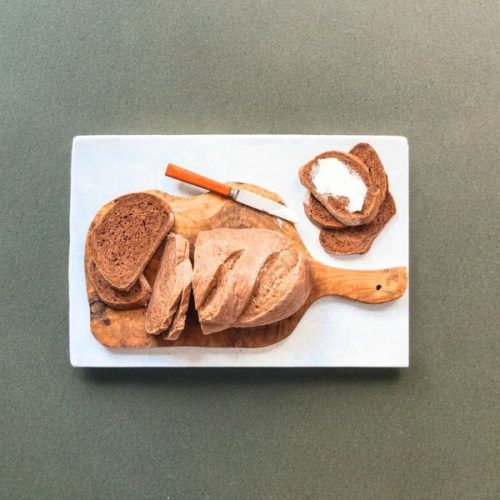
Healthy Rye Bread You’ll Love
A flavorful homemade rye bread combining the rich taste of rye flour, molasses, and caraway seeds. This recipe offers a wholesome, fiber-rich loaf with a tender crumb and satisfying chew, perfect for daily baking.
Equipment
- 1 Large Mixing Bowl
- 1 Wooden Spoon
- 1 2 bread loaf pans (8x4 inch) or baking sheet
- 1 Plastic wrap or damp cloth
- 1 Optional: Baking stone
Ingredients
- 2 packages active dry yeast 4 ½ teaspoons or 16 grams
- 2 ½ cups warm water just barely warm to the touch
- ⅔ cup molasses regular, not blackstrap
- 2 tablespoons caraway seeds optional
- 1 tablespoon salt
- ¼ cup vegetable oil
- ¼ cup unsweetened cocoa powder
- 2 cups rye flour
- 5 cups bread flour
Instructions
- Activate the Yeast: Begin by dissolving the active dry yeast in the warm water, ensuring the water feels just barely warm to the touch to avoid killing the yeast.Stir in the molasses thoroughly, creating a sweet yeast mixture. Let it sit for 5–10 minutes until it becomes foamy and bubbly, indicating the yeast is active and ready.
- Combine Initial Ingredients: Into the large mixing bowl containing the yeast mixture, add the caraway seeds if using, followed by the salt, vegetable oil, and unsweetened cocoa powder. Mix these ingredients gently with a wooden spoon to incorporate the flavors evenly before adding any flour.
- Add Flours and Mix Dough: Add 2 cups of rye flour to the bowl and stir well to blend it into the liquid mixture. Then add 2 cups of bread flour, mixing after each addition to develop the dough’s consistency. Continue adding bread flour one cup at a time, stirring until the dough becomes too stiff to mix with the spoon.
- Transfer and Knead Dough: Sprinkle half a cup of flour onto a clean, flat surface and turn the dough onto it. Knead by pressing down with the heel of your hand, stretching, folding, and turning the dough in quarters. Continue kneading for 5–7 minutes, adding more flour as needed, until the dough is smooth, elastic, and no longer sticky.
- First Rise: Lightly oil a large bowl and place your kneaded dough inside, turning it so every side is coated with oil to prevent drying. Cover the bowl tightly with plastic wrap or a damp cloth and let it rise in a warm spot for 1 to 1½ hours, or until the dough doubles in size.
- Shape the Loaves: After the dough has risen, gently punch it down to release excess air. Turn it onto a lightly floured surface, knead briefly to smooth it out, and cut it into two equal portions using a sharp knife. Shape each portion into a loaf by folding and tucking the dough into a tight oval or rectangle.
- Prepare for Second Rise: Place each shaped loaf into oiled 8x4-inch bread pans or directly onto a cornmeal-dusted baking sheet if baking freeform. Cover again with plastic wrap or a damp cloth, allowing the dough to rise for 30 to 45 minutes, until it increases by about half and just begins to peek over the pan edges.
- Preheat the Oven and Score (if needed): While the dough rises, preheat your oven to 350°F (175°C). If using a baking stone, place it in the oven at least 30 minutes before baking. Just before placing the bread in the oven, score the tops of the loaves with a sharp knife to help control expansion and create a decorative finish.
- Bake the Bread: Transfer the loaves to the oven and bake for 40 to 50 minutes. If available, mist the bread with water during the first 10 minutes of baking to develop a crisp crust. The bread is done when it sounds hollow when tapped on the bottom and has a deep brown crust.
- Cool and Serve: Remove the bread from the oven and allow it to cool completely on a wire rack before slicing.Cooling lets the crumb set properly and prevents the bread from becoming gummy. Enjoy fresh or toasted with your favorite spreads or meals.
Notes
- Use warm water carefully; too hot will kill the yeast, too cold will slow fermentation.
- Cocoa powder adds depth to the rye bread’s color and flavor without making it taste like chocolate.
- Caraway seeds are optional but provide a classic rye flavor that pairs well with savory dishes.
- For a crustier loaf, bake directly on a preheated baking stone instead of pans.
- Store bread in an airtight container or bread box to maintain freshness up to 3 days, or freeze slices for longer storage.